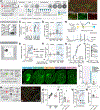Molecular and circuit determinants in the globus pallidus mediating control of cocaine-induced behavioral plasticity
- PMID: 39153478
- PMCID: PMC11502257
- DOI: 10.1016/j.neuron.2024.07.018
Molecular and circuit determinants in the globus pallidus mediating control of cocaine-induced behavioral plasticity
Abstract
The globus pallidus externus (GPe) is a central component of the basal ganglia circuit that acts as a gatekeeper of cocaine-induced behavioral plasticity. However, the molecular and circuit mechanisms underlying this function are unknown. Here, we show that GPe parvalbumin-positive (GPePV) cells mediate cocaine responses by selectively modulating ventral tegmental area dopamine (VTADA) cells projecting to the dorsomedial striatum (DMS). Interestingly, GPePV cell activity in cocaine-naive mice is correlated with behavioral responses following cocaine, effectively predicting cocaine sensitivity. Expression of the voltage-gated potassium channels KCNQ3 and KCNQ5 that control intrinsic cellular excitability following cocaine was downregulated, contributing to the elevation in GPePV cell excitability. Acutely activating channels containing KCNQ3 and/or KCNQ5 using the small molecule carnosic acid, a key psychoactive component of Salvia rosmarinus (rosemary) extract, reduced GPePV cell excitability and impaired cocaine reward, sensitization, and volitional cocaine intake, indicating its therapeutic potential to counteract psychostimulant use disorder.
Keywords: behavioral vulnerability; carnosic acid; chemogenetics; cocaine; dopamine; drug abuse; globus pallidus; intrinsic excitability; rabies virus; ventral tegmental area; voltage-gated potassium channels.
Copyright © 2024 The Authors. Published by Elsevier Inc. All rights reserved.
Conflict of interest statement
Declaration of interests The authors declare no competing interests.
Figures








Update of
-
Molecular and circuit determinants in the globus pallidus mediating control of cocaine-induced behavioral plasticity.bioRxiv [Preprint]. 2024 May 30:2024.05.29.596557. doi: 10.1101/2024.05.29.596557. bioRxiv. 2024. Update in: Neuron. 2024 Oct 23;112(20):3470-3485.e12. doi: 10.1016/j.neuron.2024.07.018. PMID: 38853899 Free PMC article. Updated. Preprint.
References
-
- Ungless MA, Argilli E, and Bonci A (2010). Effects of stress and aversion on dopamine neurons: Implications for addiction. Preprint, https://doi.org/10.1016/j.neubiorev.2010.04.006 10.1016/j.neubiorev.2010.04.006. - DOI - PubMed
MeSH terms
Substances
Grants and funding
- P30 AR075047/AR/NIAMS NIH HHS/United States
- S10 RR025496/RR/NCRR NIH HHS/United States
- T32 GM136624/GM/NIGMS NIH HHS/United States
- P30 CA062203/CA/NCI NIH HHS/United States
- R01 NS130044/NS/NINDS NIH HHS/United States
- DP2 AG067666/AG/NIA NIH HHS/United States
- R01 NS107671/NS/NINDS NIH HHS/United States
- R00 DA041445/DA/NIDA NIH HHS/United States
- F30 DA056215/DA/NIDA NIH HHS/United States
- S10 OD021718/OD/NIH HHS/United States
- R01 DA056599/DA/NIDA NIH HHS/United States
- R01 DA054374/DA/NIDA NIH HHS/United States
- S10 OD010794/OD/NIH HHS/United States
- U54 CA217378/CA/NCI NIH HHS/United States
LinkOut - more resources
Full Text Sources
Molecular Biology Databases

